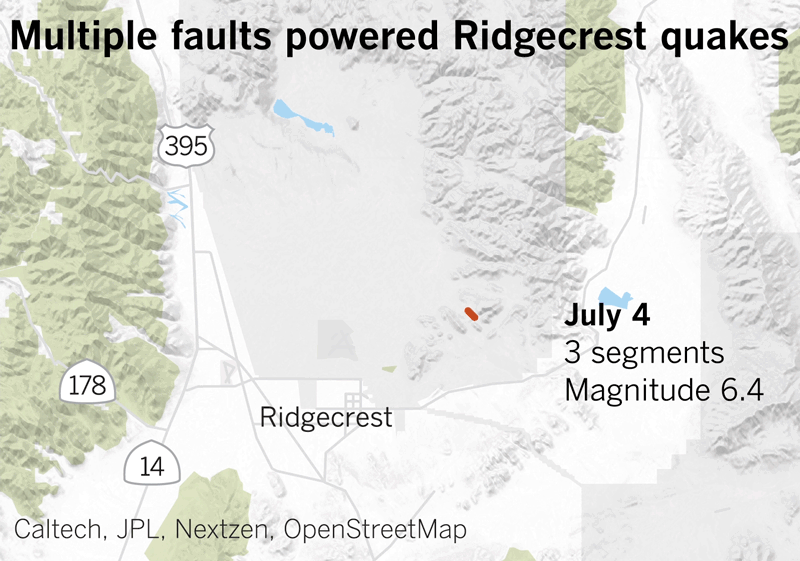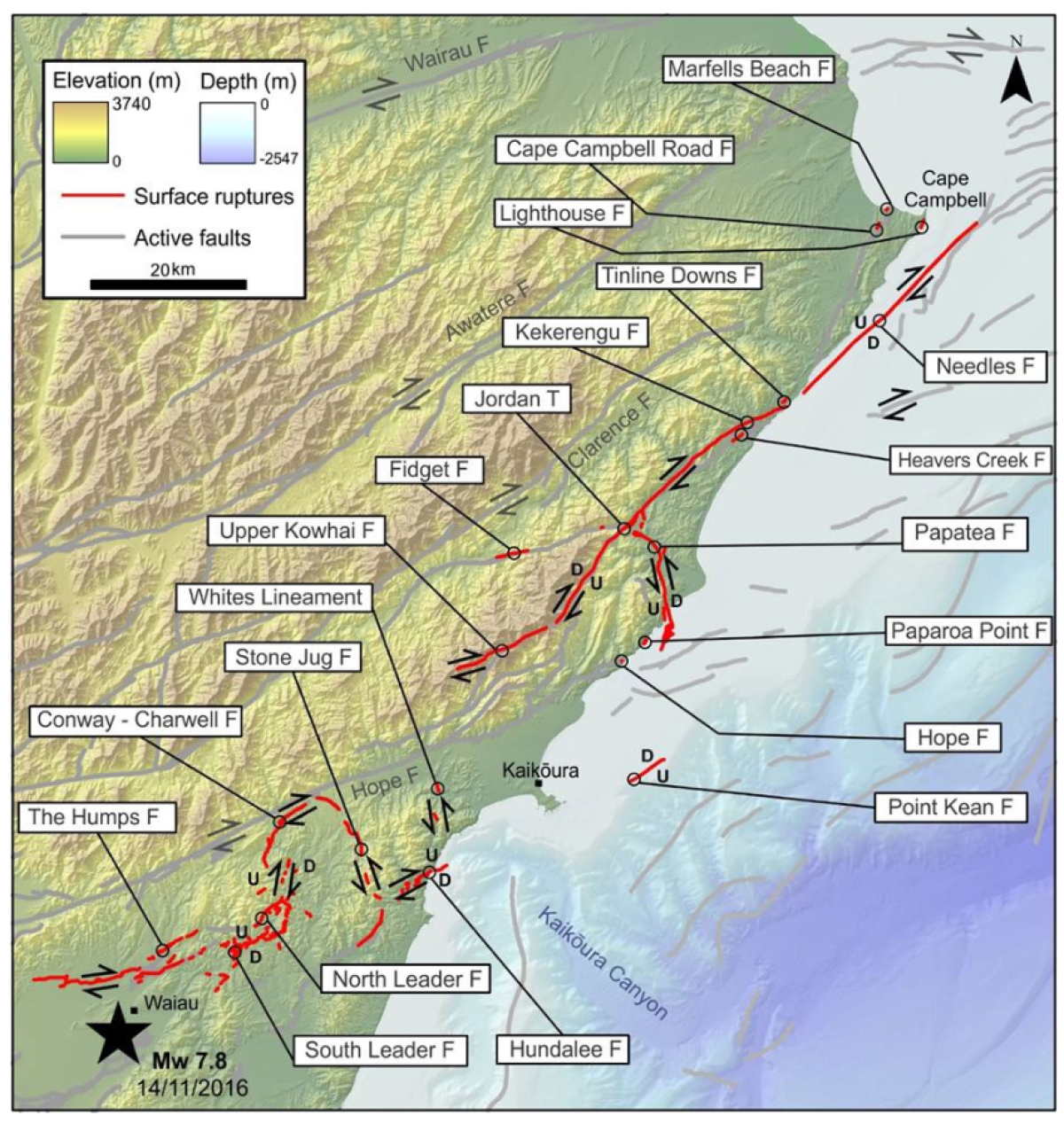Biggest California earthquake in decades ruptured on at least 24 faults
- Share via
When an earthquake strikes, the instinct of many Californians is to ask: Which fault ruptured — the Newport-Inglewood, the Hayward, the mighty San Andreas?
But scientists are increasingly saying it’s not that simple.
New research shows that the Ridgecrest earthquakes that began in July ruptured at least two dozen faults. It’s the latest evidence of how small faults can join together to produce a large earthquake, and how those quakes can cover a wider area than expected.
The findings are important in helping understand how earthquakes can grow in the seconds after a fault ruptures, when two blocks of earth move away from each other. In areas blanketed by a crisscross pattern of faults, an earthquake on a smaller fault can destabilize bigger ones, beginning a process that leads to a much stronger earthquake.
In the case of Ridgecrest, some follow-up earthquakes came seconds after; the largest one came some 34 hours later.
It has only been in recent decades that earthquake scientists have understood how smaller faults in California join together to create a more powerful earthquake.
After the 1992 Landers earthquake, scientists were astonished to find that the magnitude 7.3 temblor in the Mojave Desert had ruptured on five separate faults.
As the years have gone by, more evidence has accumulated that earthquakes can and do happen on multiple faults — such as the magnitude 7.1 Hector Mine earthquake, about 20 miles east of the Landers quake, and the magnitude 7.2 quake on Easter Sunday 2010 near Mexicali.
Detailed observations, outlined recently in the journal Science by experts at Caltech and NASA’s Jet Propulsion Laboratory, underscore how scientists’ understanding of earthquake fault ruptures has evolved.
Researchers discovered the Fourth of July Ridgecrest temblor was actually three distinct earthquakes — magnitudes 6.1, 6.2 and 6.2 — on a trio of faults. Added together, they produced enough energy to create a magnitude 6.4 temblor, said Zachary Ross, Caltech assistant professor of geophysics, the lead author of the paper. The first two quakes ruptured at right angles to each other, forming the shape of the capital letter L: the first to the northwest and southeast, the second to the southwest. The third quake also ruptured to the southwest. The faults ruptured over 12 seconds.
“That’s something we haven’t seen before, and it’s detailed on such a small scale,” said Caltech seismologist Egill Hauksson, a coauthor and expert on Southern California seismology.
The second large quake, on July 5, was actually made up of four smaller events that ruptured over 22 seconds, producing a magnitude 7.1 event, the most powerful in California in the last 20 years. In that same event, at least 20 smaller faults that intersected the main faults also ruptured, according to the study, making the zone of land atop moving faults wider than might be expected.

“The geometry of this fault network is just incredibly complicated,” Ross said. “These faults are unmapped ... many of them are at right angles to each other; they’re cross-cutting each other. In the central portion of it, they are spaced a few kilometers apart, like dominoes. There’s 20 of them in a row. This 7.1 ripped through all of these.”
The results provide even more evidence to support the idea that California faults once thought to be limited by their individual length can actually link together in a much more massive earthquake.
For instance, as cited in a 1993 study in the journal Science coauthored by Hauksson, previous estimates had suggested only earthquakes of magnitude 6.9 or less would be expected in the Landers area. The magnitude 7.3 earthquake that hit produced quadruple the shaking energy of what had been expected.
“The point is that the Landers earthquake and this earthquake are daisy-chaining up faults that previously were thought to rupture only by themselves, and that’s an important observation,” Hauksson said. “These earthquakes have connected together segments that were thought to be independent before but now have been shown to actually connect in one big earthquake.”
So instead of earthquake strain being relieved by many magnitude 6 temblors over a number of faults, “you could just do it in one magnitude 7 by having the rupture travel up and jump from one fault to the next,” Hauksson said.
A modest fault that begins to move in a quake can make it easier for a neighboring fault to rupture, Hauksson said. In Ridgecrest, the Fourth of July earthquakes probably kept on hammering strong spots along seismically strained faults until the larger magnitude 7.1 ruptured on July 5, Hauksson said.
The study raises the possibility that past earthquakes actually may have been bigger than previously thought. A prehistoric earthquake currently identified by a rupture of a fault at one site might have produced even more power if scientists haven’t yet discovered other fault segments that ruptured in the same event, the study said.
That may sound ominous. But there’s a silver lining, according to seismologist Lucy Jones, who was not involved in the study.
If supersized earthquakes are more likely, that means there would be fewer damaging temblors over any given time period. “You won’t need to have another earthquake for a much longer time,” Jones said.
“What’s worse, one 8, or six 7.5s?” Jones asked. “It’s not clear that one 8 is worse than six 7.5s. There’s a lot of damage that happens in each individual event.”
And at high magnitudes, there’s only so much the ground can shake before the rocks break; so the worst shaking caused by a magnitude 7 quake and a magnitude 8 is not that much different. A magnitude 8 quake, however, would bring destructive shaking to a much larger area of California, and its duration would be longer.
The Ridgecrest study and information gleaned from other recent quakes also has highlighted the importance of understanding how ruptures along multiple faults may affect a broader area.
In New Zealand, scientists were stunned at the bizarre map of the faults ruptured in the magnitude 7.8 Kaikoura earthquake of 2016, resembling an upside-down trident aimed at the silhouette of an eagle.

“In the Kaikoura earthquake, there were multiple ruptures over a wide area ... and that’s kind of mind-boggling,” Hauksson said. “And it’s important because that means a lot more people are affected — the surface rupture and the surface ground shaking are spread over a much wider area.”
On a practical level, the research underscores the potential limitations of state earthquake zones designated to prevent new construction directly on top of faults, Hauksson said. If a single major fault can be crossed by many shorter perpendicular faults, and officials want to avoid new construction on top of active faults, the zones might need to be larger than they are now, he said.
Further analysis needs to be done to determine whether the 20 cross faults identified in the Ridgecrest study using computer analysis of shaking records actually broke the ground at the surface, according to Tim Dawson, a senior engineering geologist with the California Geological Survey.
The Ridgecrest quakes occurred in a region already known to be profoundly complex, where there are many structurally immature, baby faults that criss-cross one another, said USC earth sciences professor James Dolan.
“It’s just very, very interesting to see one of these fault meshes all breaking at the same time in a big earthquake,” Dolan said.
A significant achievement of this study, Dolan said, was being able to image what faults look like deep underground, at a depth where earthquakes begin. The old conventional wisdom was that the structurally complex nature of faults at the surface becomes simplified the deeper you go; what this study proves is that the structural complexity continues deep underground where earthquakes begin, Dolan said.
That’s important, Dolan said, because it may help scientists determine where future earthquakes are likely to stop, which tends to happen where faults become structurally complicated.
More to Read
Sign up for Essential California
The most important California stories and recommendations in your inbox every morning.
You may occasionally receive promotional content from the Los Angeles Times.











